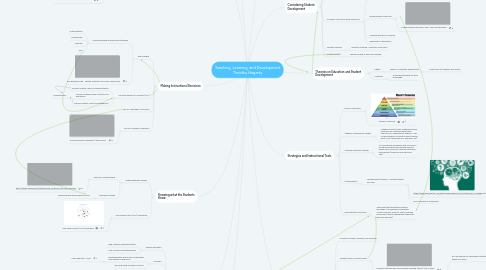
1. Views of Learning
1.1. Cognitive
1.1.1. Focus on mental processes
1.1.1.1. Deals with root of problem
1.2. Behaviourist
1.2.1. Focus on addressing behaviour
1.2.1.1. Deals with problem at surface level
1.3. Socio-Cultural/Constructivist
1.3.1. Believes behaviour caused by both social and personal
2. Establishing a Positive Learning Environment
2.1. Dynamic Classroom Management
2.2. Addressing the Three Fundamental Student Needs
2.2.1. Belonging
2.2.2. Autonomy
2.2.3. Success
2.3. Understanding Students
2.3.1. A "One Size Fits All" Approach does not work
2.3.1.1. The Myth of Average: Todd Rose at TEDxSonomaCounty
2.4. Students need to be Taught Skills and Motivation
2.4.1. Teaching only academic content is not effective in a changing world
2.4.1.1. Tony Wagner - Most Likely to Succeed
2.5. Give students Autonomy and Responsibility
2.5.1. This will teach them to Self-Regulate
2.6. Understand that Kids do Well if they Can, Not if they Want to
2.6.1. Kids Do Well if They Can Ross Greene #1
3. Making Instructional Decisions
3.1. Zoe Branigan
3.1.1. Uses Specialized Instructional Strategies
3.1.1.1. Differentiation
3.1.1.2. Technbology
3.1.1.3. Diversity
3.1.1.4. UDL
3.1.2. Zoe Branigan-Pipe - Letting Students Hack Their Lesson Plan
3.2. Universal Design for Learning (UDL)
3.2.1. Provide Multiple Means of Representation
3.2.2. Provide Multiple Means of Action and Expression
3.2.2.1. Differentiation
3.2.3. Provide Multiple Means of Engagement
3.3. Plan for Meaningful Instruction
3.4. Be Your Students' Champion
3.4.1. Every kid needs a champion | Rita Pierson
4. Knowing what the Students Know
4.1. Understanding by Design
4.1.1. Teach for Understanding
4.1.1.1. https://www.youtube.com/watch?time_continue=1&v=d8F1SnWaIfE
4.1.2. Backwards Design
4.1.2.1. Beginning with the end goal in mind
4.2. How People Learn (HPL) Framework
4.2.1. How People Learn (HPL) Framework
5. Individual Differences
5.1. Special Education
5.1.1. High-Incidence Exceptionalities
5.1.2. Low-Incidence Exceptionalities
5.2. Inclusion
5.2.1. Exceptionalities should not be separated from Regular Classrooms
5.2.1.1. Login Required - OWL
5.2.2. We must build Inclusive Practices
5.3. Learning for All
5.3.1. https://www.ldatschool.ca/wp-content/uploads/2014/04/guide-1.png
5.3.1.1. Login Required - OWL
5.4. Intelligence
5.4.1. "It is best to think of intelligence as groups of intellectual behaviours, both goal-directed and adaptive, that can have a significant impact on how, and how well, students learn" (Edmunds and Edmunds 193)
6. Standardized Tests
6.1. Standardized Tests are "imperfect instruments" (Edmunds and Edmunds 276)
6.1.1. Do not account for differentiation
6.1.2. They can be improved by preparing students for them
6.1.3. Teachers must ask questions about students test scores
6.1.3.1. Does this score make sense? If not, why?
6.1.3.1.1. Did I as a teacher not prepare the students well enough?
6.1.3.1.2. Maybe the student just had a bad day
6.1.3.2. Does this score reveal growth?
6.1.3.3. Does this score line up with the student's other grades?
6.1.4. Test scores are only one part of the picture
6.1.4.1. Teachers must use various assessment methods to ensure fair evaluation of types of students
6.1.5. Though every measure is taken to ensure they are as fair as possible
6.1.5.1. How EQAO Tests are Created, Administered and Scored
7. Theories on Education and Student Development
7.1. Piaget
7.1.1. Theory of Cognitive Development
7.1.1.1. Innate Drive to Organize and Adjust
7.2. Vygotsky
7.2.1. Scaffolding/Building off prior knowldege
8. Planning for the Upcoming School Year
8.1. Student Autonomy
8.1.1. Allowing Students the chance at Self-Governance in the Classroom
8.1.1.1. Promote Self-Regulated Learning
8.2. Reflective Practice
8.2.1. Be a Reflective Practitioner
8.2.1.1. Research Process
8.3. Curricular and Instructional Planning
8.3.1. Your own Unique Approach in Concert with Curriculum Expectations
8.4. Four Commonplaces of Education
8.4.1. Teacher
8.4.2. Topic
8.4.3. Setting
8.4.4. Student
9. Considering Student Development
9.1. Development
9.1.1. Physical, Cognitive, and Social Changes
9.2. Foster a 'Growth Mindset'
9.2.1. Allow students the freedom to experiment without fear of making mistakes
9.2.1.1. Students will then be more likely to embrace challenges
9.2.2. In opposition with a 'fixed mindset' in which students fear embarrassment and repercussions in class
9.3. Consider Why a Student is Having Difficulty
9.3.1. There is usually a reason that can be identified/solved by using the 'Research Process'
9.4. Consider Your Instructional Approach
9.4.1. Teacher Vs. Student Centric
9.4.2. Differentiated Instruction
9.4.2.1. Differentiated Instruction: Why, How, and Examples
9.4.3. Universal Design for Learning
9.4.4. Response to Intervention
9.5. Teacher Planning
9.5.1. Effective Planning = Effective Instruction
9.6. Constructivism
9.6.1. Learners active in their own learning
10. Strategies and Instructional Tools
10.1. Bloom's Taxonomy
10.1.1. Bloom's Taxonomy
10.2. Stiggins' Achievement Targets
10.2.1. "Stiggins is said to have furthered Bloom’s taxonomy by creating a hierarchical structure for “achievement targets”: a set of specifications for what students should learn or do" (Edmunds and Edmunds 125)
10.3. Universal Instruction Design
10.3.1. "An educational framework that focuses on providing students with diverse learning needs equal access to classroom teaching and learning" (Edmunds and Edmunds 293)
10.4. Metacognition
10.4.1. Thinking about thinking - considering how you learn
10.4.1.1. https://ww2.kqed.org/wp-content/uploads/sites/23/2016/08/HiRes-1440x985.jpg
10.4.1.2. Self-Assessment Techniques
10.5. Differentiated Instruction
10.5.1. "Teaching that emphasizes meeting the needs of all learners by adjusting content, process, product, and/or learning environment where appropriate" (Edmunds and Edmunds 292)
11. Socio-Cultural Considerations
11.1. Consists of Equity, Diversity, and Inclusion
11.2. Students learn in Diverse Ways
11.2.1. Different cultures may have different learning styles | How Culture Drives Behaviours | Julien S. Bourrelle | TEDxTrondheim
11.2.1.1. BUT we should not stereotype students based on culture
11.3. Critical Consciousness
11.3.1. Defined as "Perceiving social, political, and economic oppression and taking action against it" (Edmunds and Edmunds 292)
11.4. Cultural Responsiveness
11.4.1. Understanding how to incorporate the cultures, experiences, and needs of culturally and ethnically diverse students into lesson plans
11.4.1.1. https://www.youtube.com/watch?v=_uOncGZWxDc&feature=youtu.be
11.5. Understanding Effects Students' Home Lives Have on School
11.5.1. Socio-Economic Status
11.5.2. Parenting Style
11.5.3. Culture

